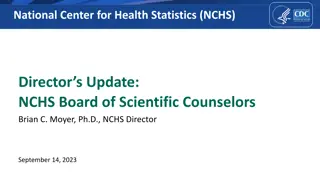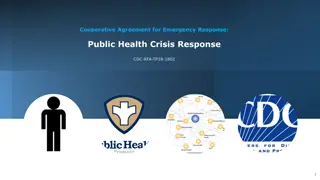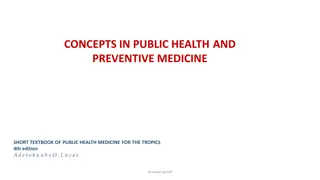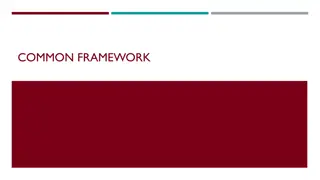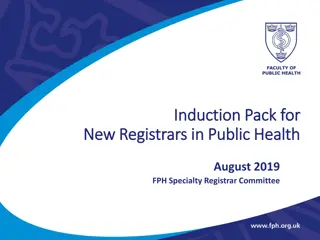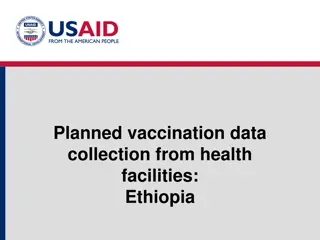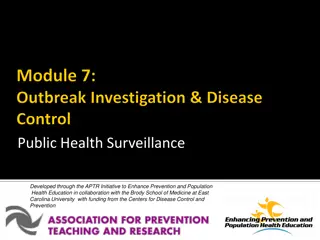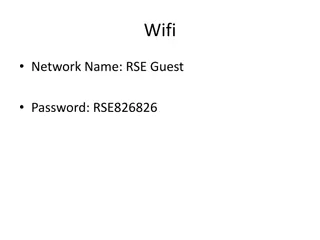
Public Health Surveillance and Data Collection
Explore the significance of public health data in assessment and surveillance, including the role of epidemiologists, biostatisticians, and demographers. Learn about key sources of public health data, such as vital statistics and national surveys, and their application in public health activities. Discover how public health surveillance systems contribute to planning, implementing, and evaluating public health practices.
Download Presentation

Please find below an Image/Link to download the presentation.
The content on the website is provided AS IS for your information and personal use only. It may not be sold, licensed, or shared on other websites without obtaining consent from the author. If you encounter any issues during the download, it is possible that the publisher has removed the file from their server.
You are allowed to download the files provided on this website for personal or commercial use, subject to the condition that they are used lawfully. All files are the property of their respective owners.
The content on the website is provided AS IS for your information and personal use only. It may not be sold, licensed, or shared on other websites without obtaining consent from the author.
E N D
Presentation Transcript
King Saud University College of Business Administration Department of Health Administration Masters` Program PA 507 Introduction to Public Health First Semester 1440/ 1441 Mohammed S. Alnaif, Ph D. alnaif@ksu.edu.sa 1 Dr. Mohammed Alnaif 21/10/1446
DATA FOR PUBLIC HEALTH LEARNING OBJECTIVES Define surveillance. Identify key sources of public health data, Census, vital statistics, national surveys, and registries. Understand the reasons why topics are chosen for surveillance activities in public health. Describe how data apply to the core public health function of assessment. Recognize the types of information available through common public health data systems. 2 Dr. Mohammed Alnaif 21/10/1446
DATA FOR PUBLIC HEALTH Public health data are key to performing the core public health function of assessment. Many of the activities that make up public health assessment and surveillance are conducted by epidemiologists, biostatisticians, and demographers, other disciplines in public health are involved as well. 3 Dr. Mohammed Alnaif 21/10/1446
DATA FOR PUBLIC HEALTH For example, data may be collected by nurses and physicians as part of their clinical and patient treatment work or by laboratory technicians and medical records specialists in health care settings. We will take a closer look at death certificate data as one key component to public health data. Death certificates form a key part of national vital statistics data 4 Dr. Mohammed Alnaif 21/10/1446
DATA FOR PUBLIC HEALTH Public health surveillance is defined as the ongoing, systematic collection, analysis, and interpretation of health-related data essential to planning, implementation, and evaluation of public health practice. Includes data collection, analysis, and dissemination to those responsible for prevention and control. Surveillance systems are useful in public health because their ongoing nature provides information over time. 21/10/1446 Dr. Mohammed Alnaif 5
DATA FOR PUBLIC HEALTH Public health surveillance Systematic, ongoing Collection Analysis Interpretation Dissemination of health outcome data Health action investigation control prevention 6 Dr. Mohammed Alnaif 21/10/1446
DATA FOR PUBLIC HEALTH Public health surveillance It is important to note that collecting data is merely one step in carrying out surveillance. A critical goal of surveillance is to control and/or prevent diseases. Therefore, any data collected must be organized and carefully examined, and any results need to be communicated to the public health and medical communities. 7 Dr. Mohammed Alnaif 21/10/1446
DATA FOR PUBLIC HEALTH Public health surveillance It is vital to communicate results during a potential outbreak so that the public health and medical communities can help with disease prevention and control efforts, but it is also important during non- outbreak times to provide information about baseline levels of disease. These baseline measurements provide important information to public health officials in monitoring health at a community level and serve as important references in any future outbreaks. 8 Dr. Mohammed Alnaif 21/10/1446
DATA FOR PUBLIC HEALTH Public health surveillance Typically, surveillance questions are consistent across populations or geographic areas. Surveillance data are useful in making decisions about what health topics to address and how and where to spend public health dollars efficiently. 9 Dr. Mohammed Alnaif 21/10/1446
DATA FOR PUBLIC HEALTH Uses of Public Health Surveillance Estimate magnitude of the problem Portray the natural history of a disease Determine distribution and spread of illness Detect outbreaks Generate hypotheses, stimulate research Evaluate control and prevention measures Monitor changes in infectious agents Detect changes in health practices Facilitate planning 10 Dr. Mohammed Alnaif 21/10/1446
DATA FOR PUBLIC HEALTH Public health surveillance There are many health problems that we might want to understand. Individuals and even the general public may have strong opinions about what topics are important enough to be included in surveillance systems. Recent public outcry about the problem of medical errors in hospitals raises the question, why don t we have a national list (or data) regarding the problem of medical mistakes? 11 Dr. Mohammed Alnaif 21/10/1446
DATA FOR PUBLIC HEALTH Public health surveillance The Agency for Healthcare Research and Quality (AHRQ) estimates that there are as many as ninety - eight thousand deaths each year in the United States due to medical errors, making it the eighth most common cause of death. 12 Dr. Mohammed Alnaif 21/10/1446
DATA FOR PUBLIC HEALTH Public health surveillance Hospitals are not the only place medical errors take place: pharmacies, nursing homes, and clinics would have to be included in surveillance as well. Currently, no consistent data collection or surveillance system for medical errors exists across the many health arenas in which they occur. However, some data are collected, and there is ongoing effort to change policies to reduce medical errors. 13 Dr. Mohammed Alnaif 21/10/1446
DATA FOR PUBLIC HEALTH Public health surveillance public cost Public health provides some of the input to help set policies, usually at the national level, regarding what to include in surveillance systems. We cannot afford to collect information on all health issues, nor would many people want to have every aspect of our health, our personal medical experiences, and our health behavior monitored. Surveillance systems require substantial time and money to establish and maintain. 14 Dr. Mohammed Alnaif 21/10/1446
DATA FOR PUBLIC HEALTH Public health surveillance public cost Therefore, six criteria are generally used to decide what health events should be chosen for surveillance activities: 1. the frequency of the health event (incidence, prevalence, mortality); 2. the severity (case-fatality, hospitalization rate, disability rate, years of potential life lost), 3. cost, (direct and indirect) 4. preventability, 5. communicability; and 6. public interest in the health event. 15 Dr. Mohammed Alnaif 21/10/1446
DATA FOR PUBLIC HEALTH Public health surveillance Outcomes Surveillance is outcome oriented. Can measure frequency of an illness or injury (e.g., number of cases, incidence, prevalence) Can measure severity of the condition (e.g., hospitalization rate, disability, case fatality) Can measure impact of the condition (e.g., cost) Orient data by person, place, and time 16 Dr. Mohammed Alnaif 21/10/1446
DATA FOR PUBLIC HEALTH Data Sources Vital Statistics Notifiable Diseases Registries Sentinel Surveillance (A condition whose occurrence serves as a warning signal) Syndromic Surveillance (Uses pre-diagnostic indicators to identify emerging health problems) Surveys Administrative Data 17 Dr. Mohammed Alnaif 21/10/1446
DATA FOR PUBLIC HEALTH Syndromes Complaints tallied into syndrome categories Death Sepsis (serious infection) Rash Respiratory (e.g., cough) Gastrointestinal (e.g., diarrhea) Unspecified Infection (fever) Neurological (e.g., dizziness) Other 18 Dr. Mohammed Alnaif 21/10/1446
DATA FOR PUBLIC HEALTH Public health surveillance public cost The issue of communicability (the disease passes from one person, object, or animal to another) is important in surveillance because by consistently collecting data about a communicable disease, we may be able to stop its spread. 19 Dr. Mohammed Alnaif 21/10/1446
DATA FOR PUBLIC HEALTH Public health surveillance public cost Think about the kinds of public announcements you may have heard on the news. In recent years, new strains of influenza virus have been identified and have spread rapidly around the globe. Influenza surveillance activities have allowed these new strains to be identified quickly and have detected how rapidly and to what areas the virus has spread. 20 Dr. Mohammed Alnaif 21/10/1446
DATA FOR PUBLIC HEALTH Public health surveillance public cost This information allows public health officials to alert the public to be vigilant about hand washing and other preventive precautions and also to be alert if traveling to or living in certain areas or participating in specific activities. Public health surveillance activities are the likely reason that these events are detected. As a result, warnings can be publicized, keeping more people from contracting an illness. 21 Dr. Mohammed Alnaif 21/10/1446
DATA FOR PUBLIC HEALTH Planning a Surveillance System Establish objectives Develop case definitions Determine data source or data collection mechanism Field test methods Develop and test analytic approach Develop dissemination mechanism Assure use of analysis and interpretation 22 Dr. Mohammed Alnaif 21/10/1446
DATA FOR PUBLIC HEALTH Surveillance Methods: Case Definition Important to clearly define condition Ensures same criteria are used by all Makes the data more comparable Include person, place, time May define suspected and confirmed cases May include symptoms, lab values, time period, population as appropriate 23 Dr. Mohammed Alnaif 21/10/1446
DATA FOR PUBLIC HEALTH Universal Surveillance Systems and Activities Typically, it is not feasible to collect surveillance information about every person in a population. However, several examples of universal (all - inclusive) surveillance systems exist, including the Census and vital statistics systems. 24 Dr. Mohammed Alnaif 21/10/1446
DATA FOR PUBLIC HEALTH Universal Surveillance Systems and Activities The Census We often overlook the decennial (every ten years) Saudi Arabia Census as a source of public health information. But in addition to providing a count of how many people reside in the Saudi Arabia, the Census contains information on where and how people live. 25 Dr. Mohammed Alnaif 21/10/1446
26 Dr. Mohammed Alnaif 21/10/1446
27 Dr. Mohammed Alnaif 21/10/1446
Saudi Arabia Census as a source of public health information National Health and Nutrition Examination Survey (NHANES) Prevalence of chronic conditions, distribution of physiologic and anthropomorphic measures, and nutritional status for representative samples of the population National Health Care Survey, includes National Hospital Discharge Survey National Ambulatory Medical Care Survey 28 Dr. Mohammed Alnaif 21/10/1446
DATA FOR PUBLIC HEALTH Objectives of the demographic survey include: 1. To provide data on the demographic and social composition of the Saudi and non-Saudis population in the Kingdom at the level of different regions in addition to extraction of indicators and demographic benchmarks, for example: Crude mortality rate in addition to the age-specific and gender- specific mortality rates Child and Infant mortality rates Total fertility rate in addition to the age-specific fertility rates The normal growth rates and natural increase in Saudi population Population age and gender structure Population structure by marital and educational status Marriage and divorce levels. 29 Dr. Mohammed Alnaif 21/10/1446
DATA FOR PUBLIC HEALTH Objectives of the demographic survey include: 2. To provide details on people with disabilities in the kingdom according to the rate, type and cause of the disability in addition to its social and demographic characteristics as well as the geographical distribution. 3. To study effects of the housing and environment characteristics on the different demographical characteristics through: Provision of the necessary housing and environment data. Provision of data needed to develop an environment improving program. 30 Dr. Mohammed Alnaif 21/10/1446
31 Dr. Mohammed Alnaif 21/10/1446
32 Dr. Mohammed Alnaif 21/10/1446
33 Dr. Mohammed Alnaif 21/10/1446
34 Dr. Mohammed Alnaif 21/10/1446
35 Dr. Mohammed Alnaif 21/10/1446
DATA FOR PUBLIC HEALTH Vital Statistics In all countries, records about births and deaths, called vital statistics, form an important part of public health surveillance. These documents are used primarily as a legal certification of births and deaths; that is, they are part of a legal and administrative system of information. For example, you typically need a certified copy of a birth certificate to enroll a child in school, and a widow needs a legal copy of a death certificate to receive pension benefits from her husband s employment. In most countries, the information from these documents is collected and used to examine trends and shifts in population health. 36 Dr. Mohammed Alnaif 21/10/1446
DATA FOR PUBLIC HEALTH Uses of Vital Statistics Data Monitoring long-term trends Identifying differences in health status within racial or other population subgroups Assessing differences by geographic area Monitoring deaths that are preventable Generating hypotheses about causation Monitoring progress toward improved health of the population; health-planning 37 Dr. Mohammed Alnaif 21/10/1446
DATA FOR PUBLIC HEALTH Vital Statistics In developing nations, documents about births and deaths may not be universally available. For example, in Turkey the government estimates that a formal death certificate is completed for about 60 percent of people who die and notes that death certificates are more common for people who live in major urban centers. By custom, Turkish people are typically buried quickly, often within twenty - four hours. The death certificate is important to have because it provides a more accurate representation of mortality and causes of death. 38 Dr. Mohammed Alnaif 21/10/1446
DATA FOR PUBLIC HEALTH Vital Statistics Birth certificates are rich sources of health information about childbirth, infant conditions, maternal health, and even social circumstances and medical care. Table 3.1 provides examples of the data collected at the time of birth that are used to describe mothers and their pregnancy experiences, the infant health and condition, and aspects of the delivery and health care. 39 Dr. Mohammed Alnaif 21/10/1446
Table 3.1 Examples of Information Available from Standard Birth Certificates Data on mothers weight at birth, smoking before and during pregnancy, diabetes, health insurance status, and prior births Age, education, height, pre-pregnancy, and Data on newborns Weeks of gestation, birth weight, sex, congenital anomalies (e.g., Down syndrome, spina bifida, limb reduction), and breast - fed at hospital discharge Data about health care Labor induced, mother s health insurance status, and cesarean section 40 Dr. Mohammed Alnaif 21/10/1446
DATA FOR PUBLIC HEALTH Survey Data These surveys form a vital component of what we know about the nation s health because they are first - hand accounts rather than information from records and observations of others. An example, The demographic surveys are one of the most important sources of data, necessary for development planning in the economic and social fields at the domestic and national levels. Its importance lies in the fact that it provides data covering the relatively long intervals between a census and another. 41 Dr. Mohammed Alnaif 21/10/1446
DATA FOR PUBLIC HEALTH Survey through these surveys, many of the demographic, economic and social phenomena can be studied in more meticulous detail than what is available in population censuses Other Survey Examples Exit interviews at health facilities Special studies Risk-behavior Cluster surveys Rapid surveillance after emergencies 42 Dr. Mohammed Alnaif 21/10/1446
DATA FOR PUBLIC HEALTH Registries A registry is a different type of data source from that which we have discussed up to now. Rather than collecting information from everyone in a population (Census, vital statistics) or selecting a representative sample of the population (surveys), registries seek to identify all individuals in a population with a specific exposure or health condition. Perhaps the most well - known example of a registry in the United States is the Surveillance Epidemiology and End Results (SEER) Program, maintained by the National Cancer Institute (NCI). 43 Dr. Mohammed Alnaif 21/10/1446
DATA FOR PUBLIC HEALTH Registries Establishing and maintaining a registry is time intensive and costly. A registry must begin with a clear case definition, a thorough description of quantifiable and objective clinical symptoms or diagnostic criteria or exposure classification, depending on the type of registry. This ensures the registry contains the individuals with the exposure or disease of interest, limiting misclassification. 44 Dr. Mohammed Alnaif 21/10/1446
DATA FOR PUBLIC HEALTH Registries Identifying the cause of a new syndrome Ideally, registries include a mechanism of active surveillance for new cases, that is, seeking out people newly exposed or diagnosed by contacting health care providers or by searching medical records. Active surveillance occurs when the health department contacts health care providers or laboratories requesting information about conditions or diseases to identify possible cases. 45 Dr. Mohammed Alnaif 21/10/1446
DATA FOR PUBLIC HEALTH Registries Passive surveillance, in contrast, occurs when health care providers or patients are encouraged to report the exposure or disease to the registry, but no case - finding effort is made by the registry personnel. The first step is passive surveillance, the local public health agencies relies on reports submitted voluntarily by local physicians and other agencies. 46 Dr. Mohammed Alnaif 21/10/1446
DATA FOR PUBLIC HEALTH Registries The major advantage of passive surveillance is that no single agency is always on the lookout for an outbreak of something, especially if they do not know what that something is or indeed anything is breaking out at all. The downside of remaining passive is that reporting is extremely sporadic. Passive surveillance can alert people that something is happening, but it cannot really say how big the problem is or where the hot spots are. 47 Dr. Mohammed Alnaif 21/10/1446
DATA FOR PUBLIC HEALTH Registries Identifying the cause of a new syndrome Active surveillance, Once an agency suspects that a problem may exist, it usually relies on active surveillance. The agency becomes more active and tries to solicit complete reporting of the new syndrome by contacting family physicians, medical officers of health, or laboratories. Depending on the degree of cooperation received, it is now possible to get a better handle on the magnitude of the problem and perhaps to develop some hypotheses about what may be causing the outbreak if there is one. 48 Dr. Mohammed Alnaif 21/10/1446
DATA FOR PUBLIC HEALTH Data Source: Administrative Data Routinely collected for other reasons. E.g., hospital discharge data collected for billing purposes, emergency department data, data collected by primary healthcare centers and other healthcare organizations. MOH publish annual statistical report. 49 Dr. Mohammed Alnaif 21/10/1446
DATA FOR PUBLIC HEALTH Usefulness of Administrative Data Depends on: What information is computerized Standardization of codes for diagnoses, symptoms, procedures, reasons for the visit (ICD-9/ICD-10) Time between occurrence of health event and availability of data Ability to link with other data systems (integration) Whether supplementary information can be obtained 50 Dr. Mohammed Alnaif 21/10/1446


